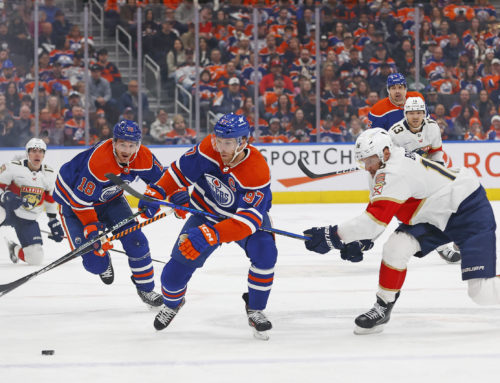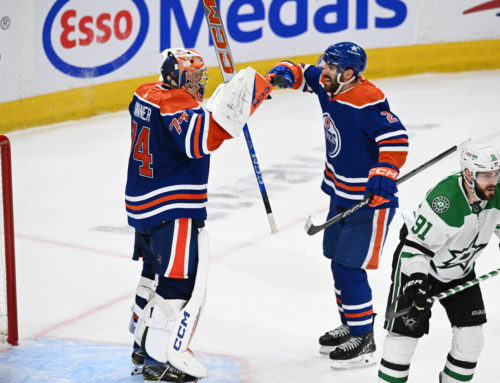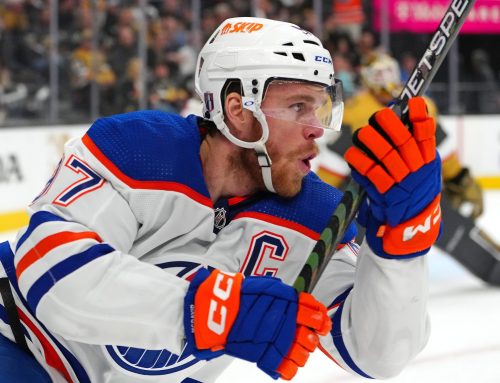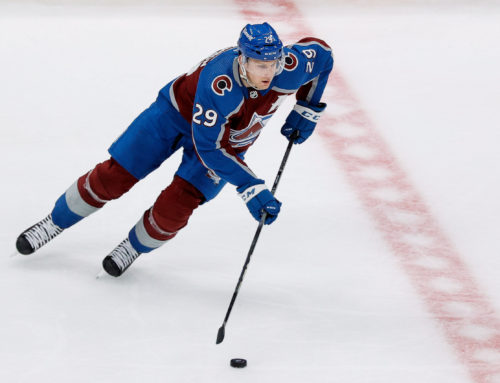Keeper League #3
Dobber Sports
2007-03-17
How to Start a Keeper League – Version #3
Here is a keeper league that involves a salary cap, with rotisserie-style scoring (12 points if you are first in a category, one point if you are last, in a 12-team league). This one is pretty cool…from Ryan.
Ryan’s Keeper Features Summary:
1. Yahoo hosted, offline drafting, money league
2. Top five teams make bank
3. 12-team rotisserie style league with 21-man rosters
4. Intricate Salary calculations
5. Salary Cap after the first year
6. Exceeding Salary Cap results in point deductions
7. Actual NHL Trade Deadline
8. Seven votes to veto. Difficult to veto because some trades are salary based.
9. IR players do not count against cap.
10. Six farm spots for players with under 25 games of NHL experience.
RULES AND REGULATIONS
League Host
1. Yahoo Fantasy Sports hosts the league.
2. All drafts are done offline, with the exception of the first draft.
A. The commissioner manually enters the rosters to Yahoo Fantasy Sports because you can not keep rosters over the off season.
Fees & Payout
1. Each team is required to pay $50 per year to stay in the league. The money distribution for the top five teams is:
$250, $125, $100, $75, $50
A. This ensures that teams are competitive long into the season, as the point of this pool is not money; it's pride.
Roster
1. Each team's roster of 21 players is divided into the following positions:
3 LW, 3 C, 3 RW, 4 D, 1 Utility (Any Position), 2 G, 5 Bench, 2 IR
2. Position eligibility is determined by Yahoo.
Scoring
1. This league is rotisserie style (see Yahoo for more information) with cumulative stats throughout the regular season only.
2. Rankings are on a scale of 1 to 12 in each of the 10 categories (6 players, 4 goalies).
2. The points you receive for each category are based on you rank.
A. If you finish first, you receive 12 points, second 11 points, and so on, until the last place team receives 1 point.
B. If there is a tie in any category, the teams receive the average points for all tied positions. If there is a tie for first (between two teams), each team receives 11.5 points ((12+11)/2). If there is a tie for first (between three teams), each team receives 11 points ((12+11+10)/3)).
2. Because there are 12 points per category and 10 categories, the maximum number of points a team can earn is 120.
A. For Players: Goals, Assists, +/-, Penalty Minutes, Power Play Points, Game Winning Goals
B. For Goalies: Goals Against Average, Save Percentage, Wins, Shutouts
Salary Formula
1. After the first season, every player who played more than 25 games will have their salary assessed using a formula.
A. For players the formula is as follows (in millions):
3Xgoals+2Xassists+2.5XPPP+3Xplus/minus+0.5XPIM+10XGWG divided by games played. This number is then added to 0.5Xgamesplayed/82.
B. For goalies the formula is as follows:
(5Xwins+10Xshutouts) divided by total games started. This number is then added to (2.5X(3-GAA)+25X(SV%-0.9)X(games started/82)+2Xgames started/82)
2. For any player who has not played more than 25 games, their stats from the previous seasons will be included until they have reached a total of 25 games, for each season added, the denominator of the last term will have 82 added to it (so if a player plays 11 games one season, and 47 the season before, they will have a total of 58 games played for their stats, and the denominator of the final term will be 164).
3. For players with less than 25 games NHL experience, they will have a salary of $1M the first year if they are picked from free agency. For prospects protected by managers (see Prospects section), they will have the following salary structure:
A. First year they are activated – $1M
B. Next year 30% of calculated salary – minimum $1M
C. Second year 60% of calculated salary – minimum $1M
D. Each year after that, the salary will be 100% of the calculated salary.
Salary Cap
1. For the inaugural season, there is no salary cap.
2. For each season after the first, the salary cap is calculated based on the total roster salaries of the team(s) that finish in the middle (before any adjustments are made for penalties exceeding the salary cap).
NOTE: that if the team(s) that finish in the middle do not have a complete roster of 21 players, the average will be taken of the number of players they do have, and that number will be multiplied by 21 to determine the roster salary of that team.
3. Teams that exceed the salary cap, will have until opening day the following season to make sure they are within the cap.
A. This can be done via trades or dropping players. At any point in the year, the current roster on any team MUST be below the salary cap. The penalty for a team exceeding this is 10 points taken from their rotisserie scores per day per million (minimum of one point per day, rounded up to the nearest million) they are over the cap. All players (including bench positions) are calculated.
Trading
1. Trading is permitted between teams up until the actual NHL trade deadline; at that point the rosters are locked.
2. Since Yahoo does not keep leagues during the off season, trading is impossible after that point, although you may discuss them with other managers.
3. To veto a trade, there must be seven votes against it. Please note however, that not all trades will be considered fair, because at certain times, teams may need to dump salary.
Injuries
A player on the IR does not count towards the salary cap, so if a player is injured, the manager can replace them with a player of equal or lesser value without being punished.
Prospects
Prospects are the backbone of building a franchise over the long term. For the sake of this league, a prospect is defined as: Any player not drafted during the inaugural draft with less than 25 games played in the NHL.
1. Teams may protect a total of six prospects at any time.
2. After the inaugural draft, a prospect draft will be held, (likely via email, with people sending an email to everyone informing them of their pick, in the correct order).
A. For the first season, each team selects three prospects (3 rounds, 1 per round).
B. The order of the draft is the reverse order of the inaugural draft.
3. Every other year, a similar draft is held after the NHL entry draft where each team selects two additional prospects.
A. With the order of the draft being the reverse order of the season results, besides the teams punished for exceeding the cap, who will draft in the last spots in order of points penalized. As an example, if teams that finish second and seventh are punished 20 and 30 points respectively, the draft order will be (in terms of last season's rankings) 12, 11, 10, 9, 8, 6, 5, 4, 3, 1, 2, 7. Like all other drafts, this will be done in a snake format.
4. Prospects/draft picks may be included in all trades; however, if the manager receiving a prospect has more than six, they must drop one. Also, a message must be posted on the league bulletin board with what prospects/draft picks are involved.
5. Once a prospect begins to play in the NHL, they will be added to the Yahoo Fantasy league. At this point, the manager has the option of whether or not to add them to their official roster.
A. The prospects remain protected by the manager until 25 games played of their SECOND season in the NHL. So, if a prospect plays 22 games in year one, the owning manager can protect them until 25 games into year two. However, if the prospect plays less than 10 games (i.e. 1-9 games), that year will not count, and everything starts from scratch again.
NOTE: that prospects drafted in the very first prospect draft have the full year of protection, plus 25 games of the next season. Any players who are not added to the roster by the time their protection expires will become a free agent. Players added to the manager's roster and later dropped are no longer protected.
6. As mentioned in the salary section, the value for any prospect is $1M for their first season. The second season is 30% of their calculated salary with a $1M minimum and the third season is 60%. After which, they are on the same salary structure of all other players.
7. The commissioner is in charge of maintaining a Microsoft Excel spreadsheet containing all managers and their prospects, including which year of play they are in. It is to be mailed to the league every time a change is made. Note that prospects who are on your roster do not count towards the six prospects you can protect.
Leaving the League
If you wish to leave the league at any point, please give as much notice as possible. In the ideal situation, a replacement will be found and they will take over your team. If no replacement is found, the roster of that team is subject to a draft (in the similar manner to the prospect draft) with the order being determined by the reverse order of the season results.
Important Dates
NOTE: example of the 06/07 season schedule. Schedule changes each year.
September 6, 2006 – Inaugural draft, live, online with Yahoo
September 13, 2006 – Prospect draft via email
October 4, 2006 – NHL Season Begins
March 8, 2007 – Trade Deadline
April 8, 2007 – NHL Regular Season Ends, Payouts Made
Early May, 2007 (and annually afterward) – Salary cap & players salaries calculated
Early August 2007 (and annually afterward) – Annual Prospect Draft





 FLA
FLA EDM
EDM NYR
NYR MIN
MIN CGY
CGY S.J
S.J ANA
ANA SEA
SEA
